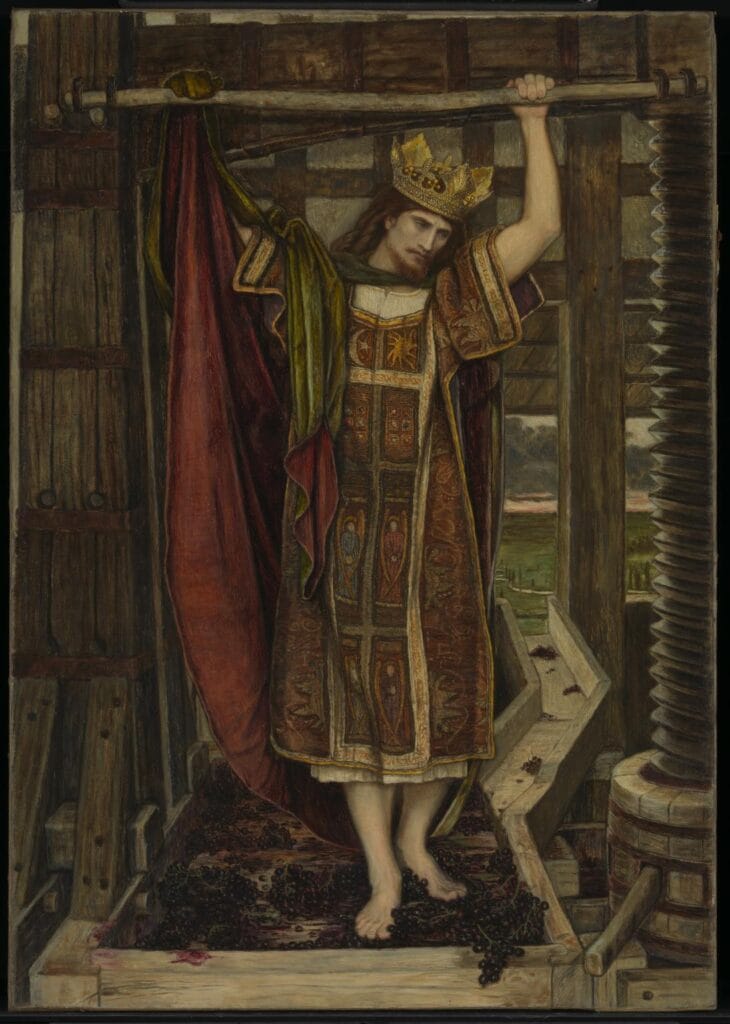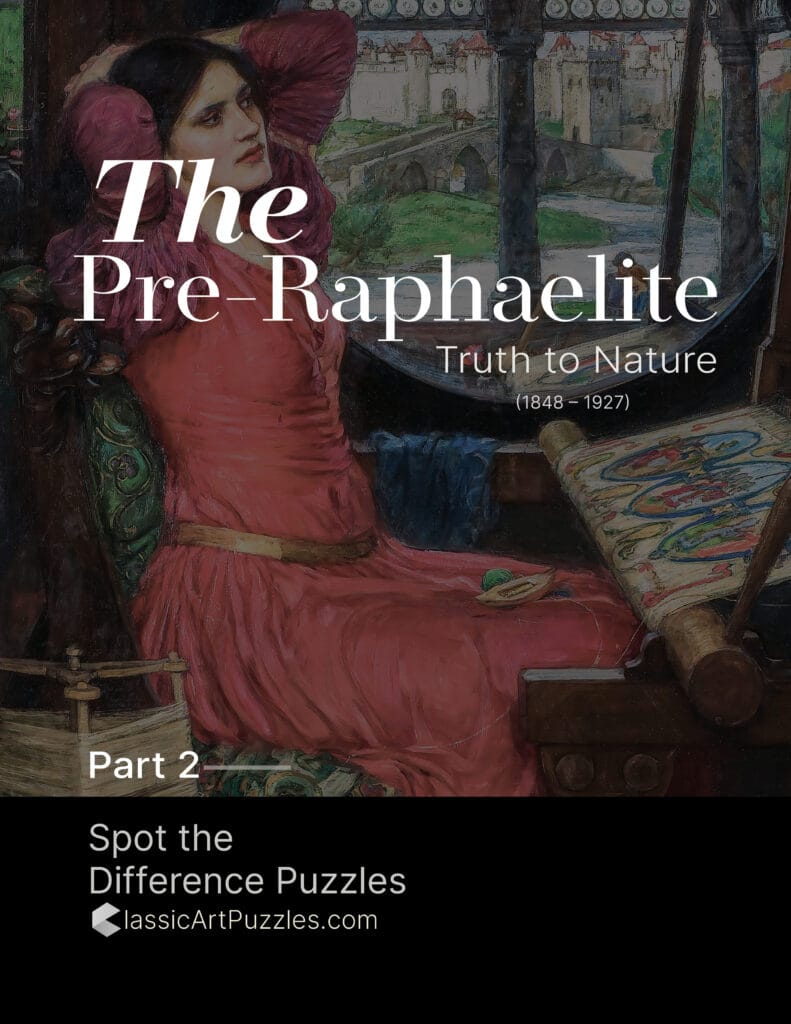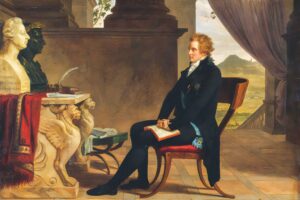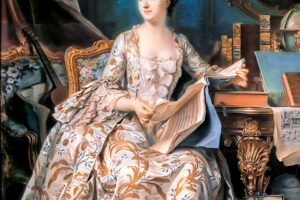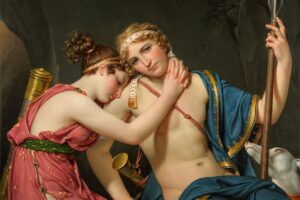Table of Contents
Overview
Painted in 1880 by John Roddam Spencer Stanhope (1829–1908), The Waters of Lethe by the Plains of Elysium is a monumental allegorical canvas that fuses classical mythology with the visionary spirit of the Pre-Raphaelites. The work depicts souls arriving at the banks of the River Lethe, where they must drink to forget earthly sorrows before entering the blissful Fields of Elysium.
Stanhope brings this myth to life with a procession of figures, each embodying human struggle, grief, or hope. Against a luminous backdrop of cypress trees and flowering meadows, the composition contrasts suffering with serenity, mortality with eternal peace.
The painting embodies the Pre-Raphaelite fascination with myth, symbolism, and moral narrative, and it remains one of Stanhope’s finest meditations on the cycle of life, death, and transcendence.
Artist
John Roddam Spencer Stanhope (1829–1908) was a British painter associated with the Pre-Raphaelite circle and the second generation of its followers. Known for his deep interest in classical mythology and religious allegory, Stanhope’s works blend vivid color, poetic intensity, and moral symbolism. He often painted in Italy, where the light and landscapes profoundly influenced his palette. Today, his work is admired for its unique fusion of classical themes with Pre-Raphaelite detail.
The Story Behind the Painting
Mythological Inspiration
In Greek mythology, the river Lethe was one of the five rivers of the underworld. Souls drank its waters to forget earthly pain before entering Elysium, the paradise reserved for the blessed.
Allegory of Redemption
Stanhope’s canvas shows this threshold between sorrow and peace. Figures weighed down with grief are gently led to drink, a necessary passage before eternal rest. The contrast between shadowed foreground and luminous background reflects the transition from despair to renewal.
Victorian Spirituality
For Victorian audiences, the subject resonated with anxieties about death and the afterlife. The Pre-Raphaelite treatment made myth a mirror for contemporary meditations on mortality, consolation, and the promise of peace.
Composition and Subjects
The Procession
A solemn line of figures moves across the canvas, each expressing sorrow or burden. Some carry children, others bow their heads in resignation. Their gestures echo human grief and longing for release.
The Waters of Lethe
The dark reflective pool dominates the lower right, its stillness contrasting with the brightness beyond. The act of drinking represents a symbolic cleansing — not destruction of memory, but liberation from pain.
The Elysian Fields
In the background, the landscape bursts into color: tall cypress trees, meadows, and dancing figures symbolize joy and eternal harmony. The promised peace of the afterlife is visible but not yet reached.
Art Style and Techniques
Pre-Raphaelite Precision
Stanhope’s technique reflects the Pre-Raphaelite focus on detail: rich colors, intricate drapery, and naturalistic settings imbued with symbolism.
Symbolic Use of Light
The painting’s structure relies on contrasts: dark foreground for grief and transition, radiant horizon for renewal. This symbolic use of light was a hallmark of Stanhope’s style.
Myth Transformed
While rooted in classical mythology, the figures’ emotional realism reflects Victorian concerns — grief, mortality, and the hope of transcendence.
Featured in Our Collection
The Waters of Lethe by the Plains of Elysium is featured in our Pre-Raphaelite Spot-the-Difference Puzzle Flipbook P2. Its contrasts of shadow and light, the procession of figures, and the distant paradise make it a captivating puzzle. Through play, you can engage with every symbolic detail of this masterpiece.
The River of Forgetfulness
A solemn line moves forward, burdened with sorrow, toward the river of forgetting. Beyond, a radiant meadow awaits. Stanhope’s The Waters of Lethe is both myth and meditation, where loss becomes the threshold of peace.
More About Artist
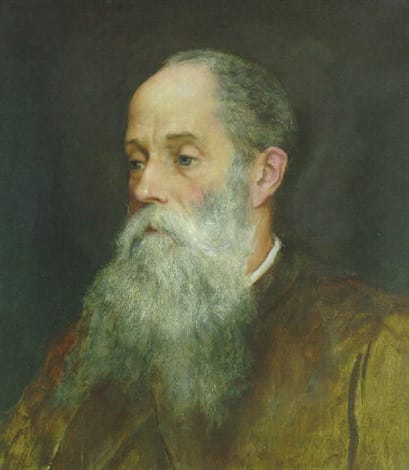
John Roddam Spencer Stanhope (January 20, 1829 – August 2, 1908) was an English artist associated with the second wave of the Pre-Raphaelite movement. Born into an aristocratic family in Cawthorne, Yorkshire, he was educated at Rugby School and Christ Church, Oxford. Despite his privileged background, Stanhope pursued a career in art, training under George Frederic Watts and traveling extensively, including trips to Italy and Asia Minor.
Artist Style and Movement
Stanhope’s work is typically classified within the later Pre-Raphaelite and Aesthetic movements of Victorian art. He worked across various media—oil, watercolor, fresco, tempera—and his subjects ranged from mythological and allegorical themes to biblical scenes and contemporary life. His early paintings featured highly original narrative compositions, which later evolved towards a more symbolic and aesthetic style influenced by broader Victorian artistic trends.
The Pre-Raphaelite Society continues to explore and share the legacy of this remarkable movement.
Artwork Profile
- Thoughts of the Past (1859), his first exhibited painting, depicting a contemplative woman by a window overlooking the Thames.
- The Shulamite: (Pastoral Scene with Lambs) (c. 1878), a serene and lyrical pastoral scene exemplifying his Pre-Raphaelite style.
- The Shulamite: (Bridal Procession) (c. 1882), depicting the procession with rich symbolism and ornate detail, continuing his Pre-Raphaelite themes.
- Penelope (1864), illustrating the faithful wife from Homeric legend in the detailed and expressive Pre-Raphaelite manner.
- Winnowing (c. 1880), portraying agricultural life with symbolic overtones typical of his narrative approach.
- Juliet and Her Nurse (c. 1860), a literary subject rich with emotional and dramatic qualities favored by Pre-Raphaelites.
- Why Seek ye the Living Among the Dead (1870–1899), a powerful biblical scene reflecting later symbolic and aesthetic tendencies.
- Love and the Maiden (1877), a romantic and allegorical composition showcasing his mature style.
- Charon and Psyche (1883), a mythological painting exploring themes of love and the afterlife.
- Pine Woods at Viareggio (1888), a landscape reflecting his time in Italy with delicate naturalism.
- The Gentle Music of a Bygone Day (1873), a nostalgic genre painting evoking memories and emotion.
- The Waters of Lethe by the Plains of Elysium (1880), a symbolic work referencing classical mythology and the afterlife.
John Roddam Spencer Stanhope’s artistic career reflects a rich engagement with the ideals of the Pre-Raphaelites, combined with a move towards aesthetic symbolism in later years. His work, characterized by technical skill and narrative depth, secured him a distinctive place in Victorian art history. Living much of his later life in Florence, he influenced subsequent artists including his niece Evelyn De Morgan, solidifying his legacy as a key figure bridging English Roman

